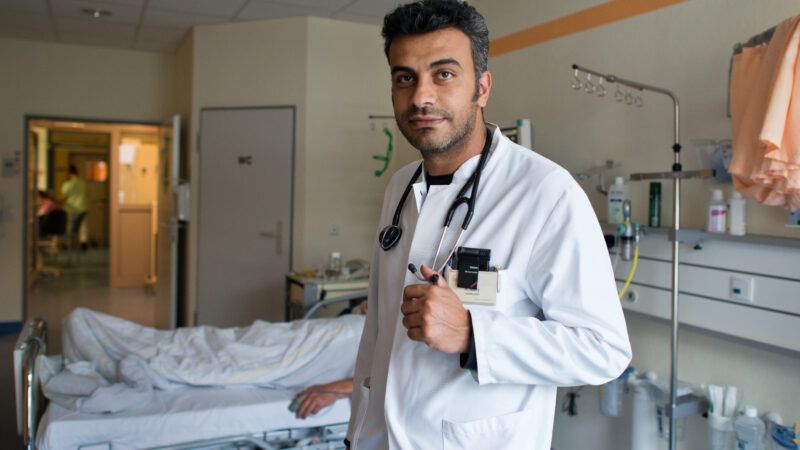Foreign Lung Doctors Can Help Coal Country Residents. We Should Let Them.
But we first need to pass a bill to let more of them into the U.S.

Since 1903, the plaque at the foot of the Statue of Liberty has extended a warm welcome to the "huddled masses yearning to breathe free," the first sign of respite for immigrants arriving to America in pursuit of a better life.
But these words can just as easily describe 26,000 coal miners fighting for their health as they suffer from the largest black lung epidemic in a quarter century. Miners in Appalachia were exposed to silica dust, a substance that is 20 times more toxic than dust from regular coal, and now as many as one in five miners from Central Appalachia are showing signs of black lung disease.
For years, coal country has relied on physicians from around the world to help manage their chronic health conditions. In Hazard, Kentucky, the only two practicing pulmonologists—doctors who specialize in lung and respiratory care—are from Syria and Bangladesh. On the national level, 30 percent of America's pulmonologists graduated from medical schools abroad, as did 87 percent of pulmonologists currently in training.
But coal country needs even more of these foreign doctors. By the next decade, almost 89 percent of America's practicing pulmonologists will have reached retirement age, and there won't be enough doctors to replace them.
The nation at large needs them, too. Even as America's supply of lung doctors dwindles, over 16 million U.S. residents live with chronic obstructive pulmonary disorder (COPD), a progressive lung disease that often affects elderly people with a history of smoking. Over one in 10 people in Kentucky and West Virginia suffer from COPD, and roughly a quarter of residents in both states are smokers. They also face greater risks of exposure to asbestos, which has been found in Appalachian waterways and soil. According to Thomas Tucker, the associate director for cancer prevention at the University of Kentucky Markey Cancer Center, smokers exposed to asbestos can be 300 times more likely than nonsmokers to develop lung cancer.
There are a number of reforms Congress could enact to enable more foreign physicians to practice in the United States and save these American lives. Some of them are included in the recently reintroduced Conrad 30 Physician Reauthorization Act.
For starters, the bill expands the Conrad 30 J-1 Waiver, a program that allows foreign physicians who completed their medical residency on a J-1 visitor visa to remain in the United States.
Normally, these physicians would be required to return to their home country for a minimum of two years before they could practice in the U.S. But preventing fully qualified doctors from providing much-needed care immediately is nonsensical. Eventually, this provision should be scrapped entirely, but for now, the Conrad 30 Waiver exempts these doctors from the requirement if they agree to practice in a medically underserved area for at least three years.
The bill would also add five extra physician slots annually to every state's 30-physician annual quota so long as these states use 90 percent of the available waivers. States using less than five of their physician slots would be excluded from this calculation so they won't impede the program's expansion in other states. This will allow states that have a high incidence of COPD to sponsor pulmonologists to help care for their residents.
The bill also offers a streamlined pathway to a green card through the National Interest Waiver (NIW), which participating physicians can qualify for if they practice in an underserved area for a total of five years, three of which can include the service required under Conrad 30. If passed, the bill would exempt NIW physicians from the worldwide green card caps, which have trapped some eligible physicians in decades of backlogs.
These reforms will be important for statewide efforts to attract more pulmonologists. The Virginia Department of Health, for example, has identified target areas where the Conrad 30 program can alleviate pulmonologist shortages. Some of these locations, like Buchanan County, are in the Southwestern region of the state, which contains the largest concentration of advanced stage black lung ever reported. When taken together, however, the number of Virginia counties listed as high priority shortage areas for pulmonologists, OB-GYNs, and primary care doctors far exceeds the program's 30 physician limit. So this is a really modest bill that should be considered only the first step in broader reforms to let far more foreign physicians in.
One such reform would be exempting them from repeating medical residencies and fellowships if they already completed them in a country whose medical standards are similar to the United States. Under the current system, an experienced pulmonologist trained abroad needs to complete a three-year residency in internal medicine plus a two-to-three-year pulmonology fellowship in America before they can practice in the United States.
Because of these duplicative requirements, there are as many as 65,000 foreign-trained physicians unable to practice in the United States, and others are taking their talents to countries that better recognize their qualifications. (In Canada, physicians from a handful of countries can bypass residency requirements for certain specialties, such as internal medicine.) Better yet, hospitals should be allowed to assess the competency of these physicians for themselves, and take responsibility for any additional training and supervision they may require.
Despite the myriad of obstacles they must jump through, foreign doctors continue knocking at America's door, eager to use their skills to care for Americans. Enacting policies that encourage more of them to come is one of the best ways to relieve the nation's doctor shortage. America has an obligation to its own citizens to welcome all the help it can get.
Sam Peak is a writer at Young Voices who specializes in immigration policy.


Show Comments (69)